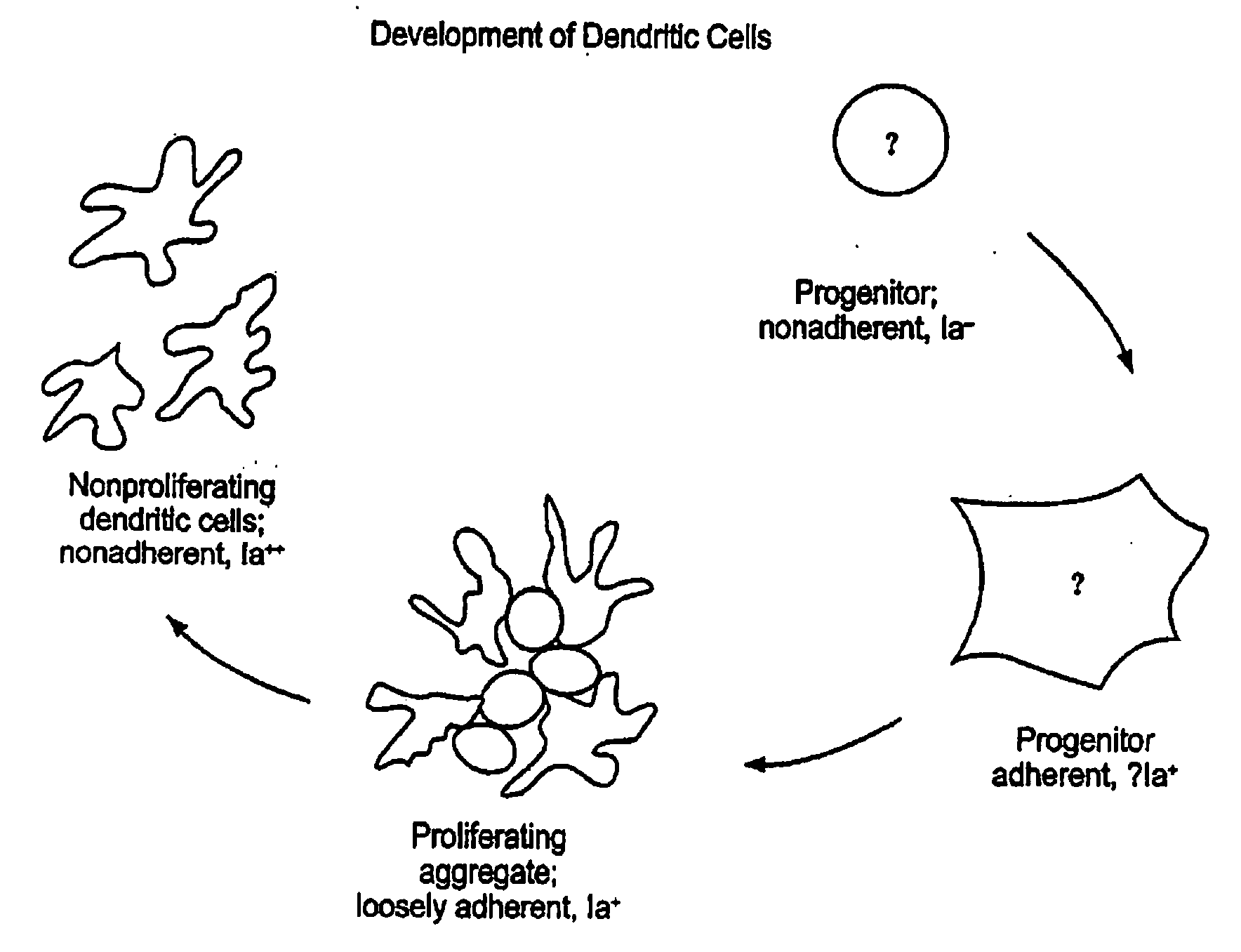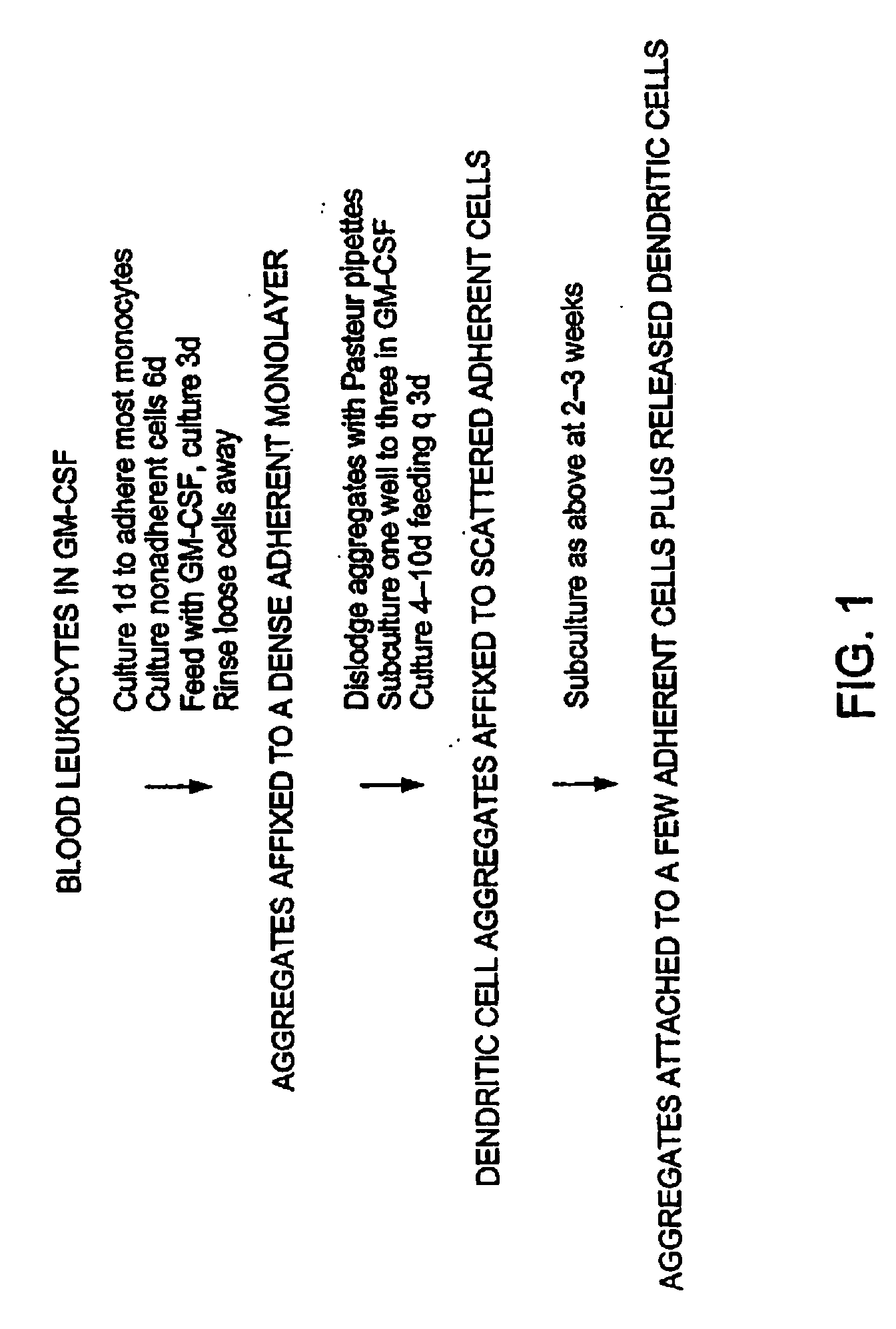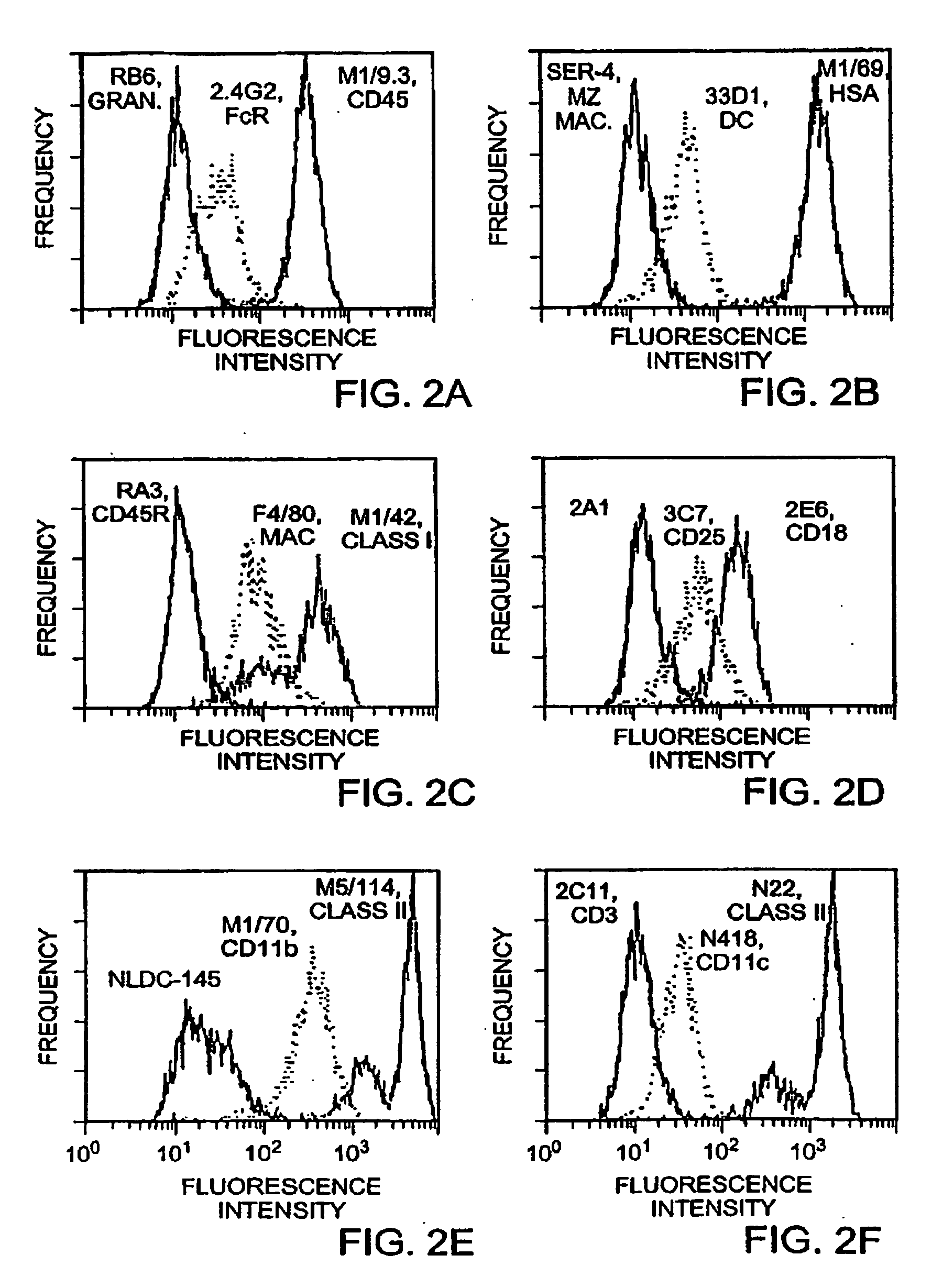Method for in vitro proliferation of dendritic cell precursors and their use to produce immunogens
a dendritic cell and in vitro technology, applied in the field of immune system culturing, can solve the problems of inability to identify proliferating dendritic cells in bone marrow, in contrast to blood, difficult identification etc., to achieve the effect of increasing the number of myeloic dendritic progenitor cells, promoting the proliferation of dendritic cell precursors, and increasing the yield of dendritic cell precursor
- Summary
- Abstract
- Description
- Claims
- Application Information
AI Technical Summary
Benefits of technology
Problems solved by technology
Method used
Image
Examples
example 1
Production of Mouse Dendritic Cells In Vitro from Proliferating Dendritic Cell Precursors from Blood
Materials
[0156]A. Mice: BALB / C, BALB / C×DBA / 2 F1, BALB / C×C57BL / 6 F1, C57BL / 6×DBA / 2 F1, and C57BL / 6 males and females, 6-8 weeks of age were purchased from Japan SLC Inc [Shizuoka, Japan], the Trudeau Institute [Saranac Lake, N.Y.], and Charles River Wiga [Sulzberg, FRG]. Four preparations of rGM-CSF were evaluated with similar results, the yield of dendritic cells reaching a plateau with 30-100 U / ml. The preparations were from Dr. S. Gillis, Immunex Corp, Seattle Wash.; Genetics Institute [supernatant from COS cells transfected with mGM-CSF; used at 30 U / ml or greater]; and Dr. T. Sudo [supernatant from CHO cells transfected with the expression vector, pHSmGM-CSF (22), and E. Coli expressed material].
B. Blood Preparation: Blood was obtained by cardiac puncture or from the carotid artery. The blood was diluted in, or allowed to drip into, RPMI-1640 with 100 U / ml heparin [about 2 ml / mous...
example 2
Generation of Large Numbers of Dendritic Cells from Mouse Bone Marrow Cultures Supplemented with GM-CSF
MATERIALS
[0181]A. Mice: Female BALB / C, male DBA / 2, and female C57BL / 6 mice, 7 wks old, were purchased from Japan SLC [Hamamatsu, Shizuoka, Japan]. BALB / C×DBA / 2 F1, of both sexes 7-10 wks old, were from Japan SLC and the Trudeau Institute, Saranac Lake, N.Y.
Reagents: The culture medium was RPMI-1640 [Nissui, Tokyo, Japan; GIBCO, Grand Island, N.Y.] supplemented with 5% FCS, 50 μM 2-Mercaptoethanol, and 20 μg / ml gentamicin. Murine rGM-CSF [108 U / mg protein] was kindly provided by Kirin Brewery Co [Maebashi, Gumma, Japan]. A panel of rat and hamster mAbs to mouse leukocyte antigens is described elsewhere (23, 24). FITC- and peroxidase-conjugated mouse anti-rat IgG were purchased from Boehringer Mannheim [Indianapolis, Ind.] and FITC- and peroxidase-conjugated goat anti-hamster Ig [γ and L-chain] were from Jackson Immunoresearch Lab [Westgrove, Pa.] and Caltag [San Francisco, Calif.] r...
example 3
Mouse Dendritic Cell Progenitors Phagocytose Particulates Sensitizing Mice to Mycobacterial Antigens In Vivo
Material and Methods
[0201]A. Mice: BALB / C×DBA / 2 F1, C57BL / 6×DBA / 2 F1, and BALB / C male and female mice were purchased from the Trudeau Institute [Saranac Lake, N.Y.] and Japan SLC [Hamamatsu] and used at 6-10 weeks of age.
B. Bone marrow cultures: As described in Example 2 above, bone marrow was flushed from the femus and tibias, depleted of red cells with 0.83% ammonium chloride, and cultured in 24 well plates [Nunc, Napaville, Ill. and Corning #25820, Corning N.Y.] at 106 cells / well in 1 ml of RPMI-1640 supplemented with 5% fetal calf serum, 20 ug / ml gentamicin, and 1000 U / ml of recombinant murine GM-CSF [Kiren Brewery, Maebashi, Gumma, Japan; 9.7×107 U / mg]. At d2, 0.75 ml of medium and the nonadherent cells were removed, and replaced with fresh medium. This was repeated at d4-5, thereby removing most of the developing granulocytes and leaving behind clusters of proliferating ...
PUM
| Property | Measurement | Unit |
|---|---|---|
| volume | aaaaa | aaaaa |
| volume | aaaaa | aaaaa |
| diameter | aaaaa | aaaaa |
Abstract
Description
Claims
Application Information
 Login to View More
Login to View More - R&D
- Intellectual Property
- Life Sciences
- Materials
- Tech Scout
- Unparalleled Data Quality
- Higher Quality Content
- 60% Fewer Hallucinations
Browse by: Latest US Patents, China's latest patents, Technical Efficacy Thesaurus, Application Domain, Technology Topic, Popular Technical Reports.
© 2025 PatSnap. All rights reserved.Legal|Privacy policy|Modern Slavery Act Transparency Statement|Sitemap|About US| Contact US: help@patsnap.com



